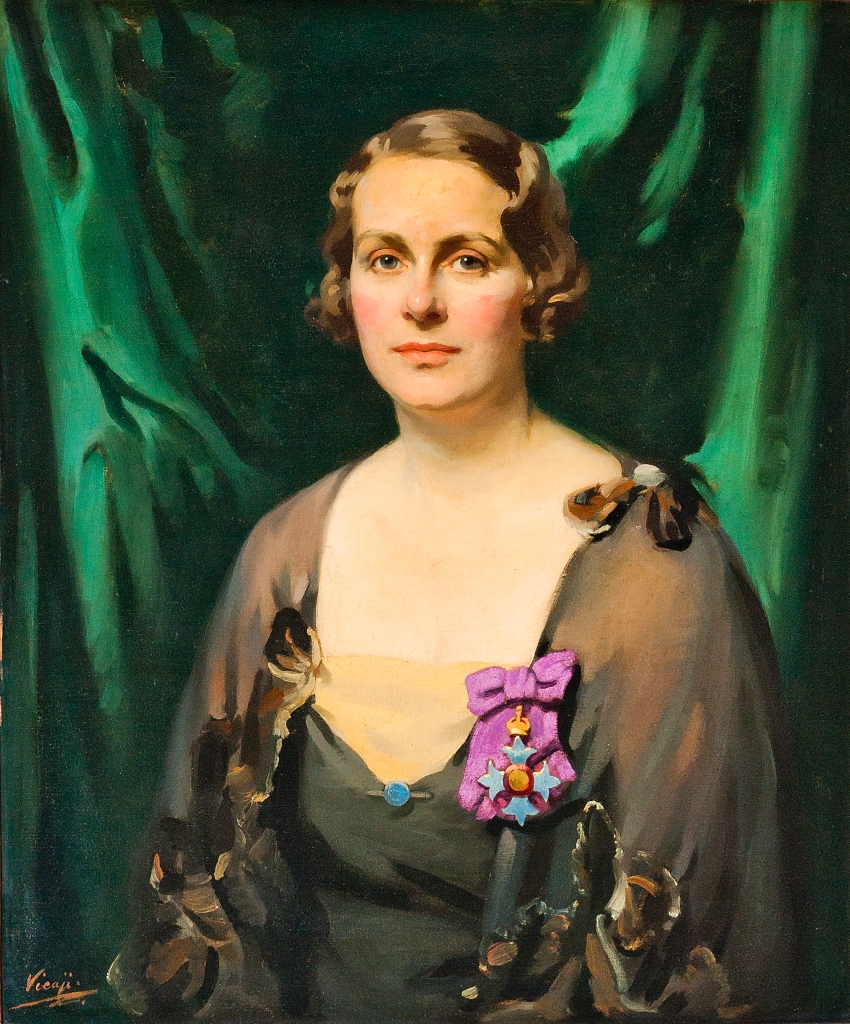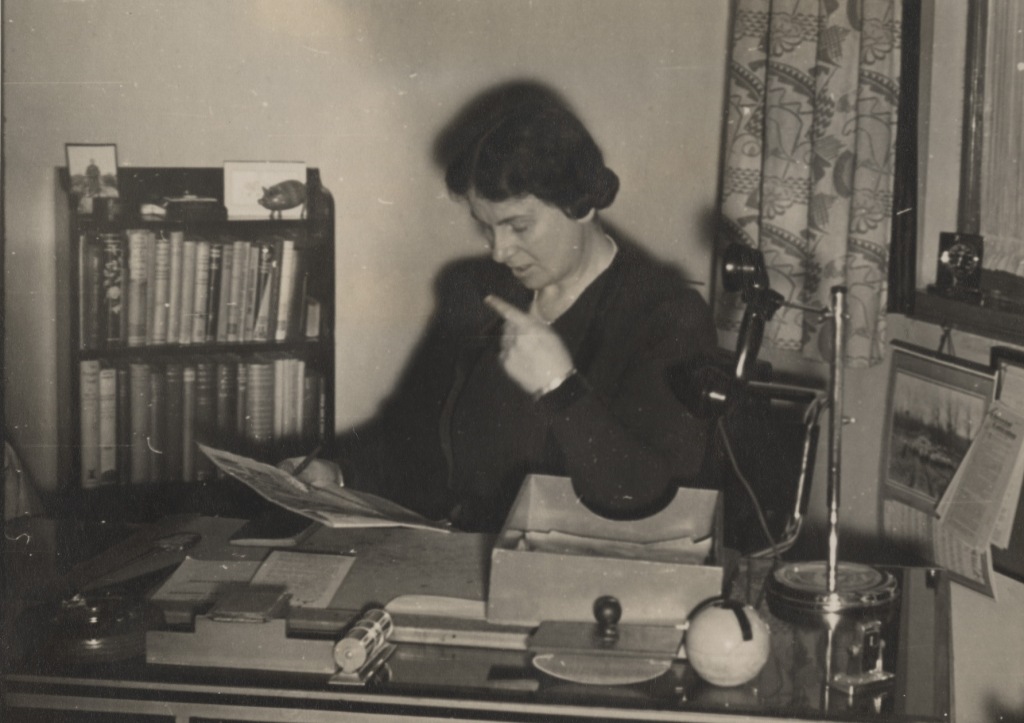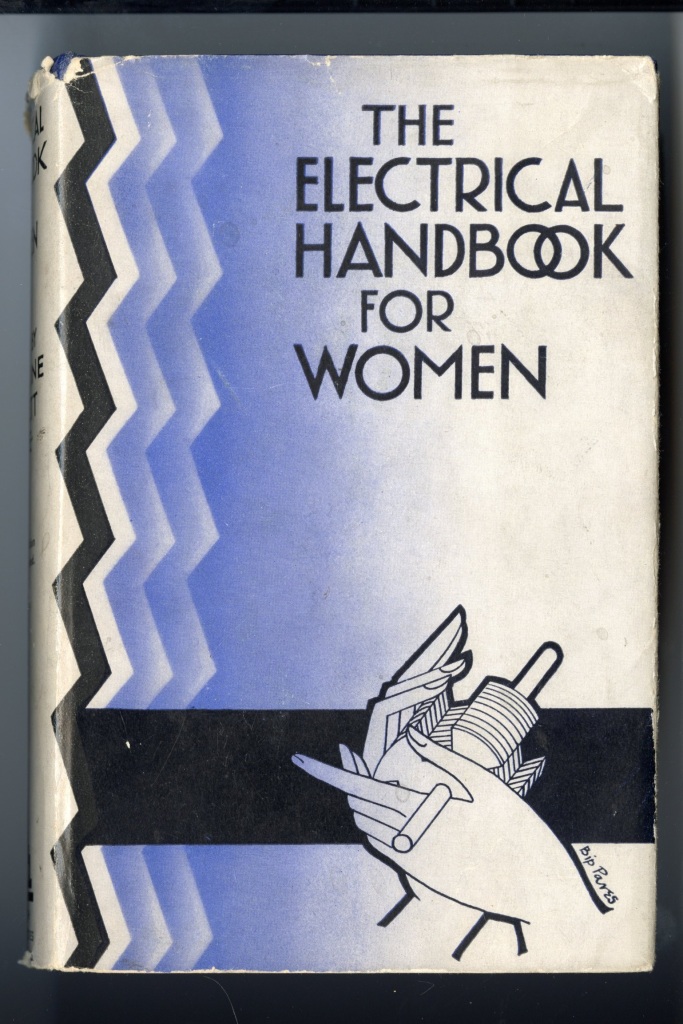Guest blog by Isabella Fletcher, University of Leeds
This is the third blog in the series written by Liberal Arts students at the University of Leeds to celebrate the EAW’s centenary in 2024. This project has been supported by Professor Graeme Gooday. These blogs on early EAW activities are based on themes that the students selected from reading digitised versions of the first two volumes (1926-1935) of The Electrical Age (for Women). The first blog is on the EAW’s Presidents and the second on its regional branches.
Who was Caroline Haslett?
Caroline Haslett was born in 1895 in Worth, Sussex and was the daughter of Robert Haslett and Caroline Sarah (formerly) Holmes. In her early life, she joined the suffragette movement and also worked for the Cochran boiler company, where she gained basic engineer training. This was the foundation for her life’s work as a ‘pioneer for women in the electrical and professional world’ (IET biography).
This blog post will highlight some of Caroline Haslett’s leading achievements in her career and how they have made a lasting impact on the process of electrification, as well as women’s involvement.
A career in women’s rights and electrification
After leaving school, Caroline Haslett became a clerk at the Cochran boiler company due to her mother’s connections. It was here that she acquired an interest for the practical side of the work and was able to become involved due to staffing shortages in the First World War. However, in 1919 the Restoration Of Pre War Practices Act allowed and encouraged workplaces to sack women from professional positions which they did not attain prior to the war. This was a huge knock back for women’s rights, as they had caught a glimpse of what women’s involvement in the workforce could mean. Following this Act, supporting women who wished to keep a career in engineering became essential and in 1919 the Women’s Engineering Society was formed.
Caroline Haslett became the first Secretary of the Women’s Engineering Society in 1919, as well as founding and editing the Woman Engineer up until 1932 (the Woman Engineer is still published today). The Women’s Engineering Society was founded primarily to encourage the study and practice of engineering among women, but to also facilitate meetings in which conversations about the training and employment of technical women were able to flourish. Here we can see how Haslett’s passion for both engineering and opportunities for women were combined in this society.
Simultaneously to the increase in support for women in engineering, this time period also saw progress in electrification. In 1919, the Electricity Supply Act set up a national body of electricity commissioners and set the foundations for the National Grid. Furthermore, The British Electrical Development Association (EDA) and the British Electrical and Allied Industries’ Research Association (ERA) were founded in the years of 1919 and 1920. Electricity was becoming increasingly generated and popularised on a national level.
Public speaking achievements
Caroline Haslett’s impactful public speeches included addresses to diverse audiences, ranging from industry professionals to the general public. In one notable instance, she delivered a compelling speech at the Women’s Engineering Society, encouraging women to pursue careers in engineering and showcasing the significance of their contributions. Haslett’s eloquence was particularly evident in her talks on the broader societal implications of gender diversity in STEM, where she illustrated the potential benefits of harnessing the talents of both men and women in technological advancement.
In addition to formal events, Haslett engaged with the public through radio broadcasts and newspaper articles, where she passionately discussed the role of electricity in improving daily life. Her ability to communicate complex technical ideas in a way that resonated with a wide audience helped bridge the gap between the technical and non-technical spheres.
Furthermore, Haslett’s speeches during and after World War II addressed the importance of harnessing technological advancements for post-war reconstruction. Her articulate advocacy for the role of engineering in shaping the future of society made her a respected and influential figure in both technical and non-technical circles. Through these examples, it becomes clear that Haslett’s public speaking played a pivotal role in promoting her vision of a more inclusive and technologically advanced society.
The Electrical Association for Women
As electricity became increasingly widespread across the nation, Caroline Haslett worked to ensure that women were not overlooked in the electrical sphere. In 1924, Mabel Matthews approached Haslett with an idea to utilise this advancement in electricity to benefit women, by lessening the burden of their domestic work. Haslett encouraged Lady Katherine Parsons (President of the Women’s Engineering Society) to hold a meeting to discuss this and later that same year Haslett became the co-founder and Director of the Electrical Association for Women. She later became the President of the association in 1942 and remained in this position until 1956 when she was forced to retire due to ill health.
As part of her role as Director of The Electrical Association for Women, Haslett edited and published The Electrical Handbook for Women, first published in 1934. The handbook was an informative and educational guide on how electricity is useful in the home and how to best use it. The handbook also spotlighted female figures who played a vital role in the inclusion of women in the engineering domain. However, as Haslett was the editor there’s very little information about her in the handbook, instead she acts as an ever present narrator. Therefore, the following section of this blog will be driven by the editorial section of the handbook, in which Haslett decides to remain unnamed.
Caroline Haslett as editor
One reason as to why Caroline Haslett does not sign off her editorial pages or give herself a column to discuss her work in The Electrical Age, is in order to protect the validity of the publications. As Haslett did not personify the editorial voice, it can be seen to have a more neutral tone and therefore may appear to be more convincing.
Each edition contains an editorial section, in which Haslett offers a brief discussion of the content of that edition. In the first edition of the Electrical Handbook for Women, Haslett comments on the goal of the journal:
“The Electrical Age has a special mission which has not yet been undertaken by anyone else- that is, to interpret the message of electricity to the women of this country. The E.A.W, has grown so rapidly that the need for a medium to express its point of view and to report its activities has become imperative”
Electrical Handbook for Women p. 4 (1st edition)
Here, she highlights the importance of the Electrical Age at bridging the gap between women and the sphere of electrification, as well as commenting on the popularity of the association.
Haslett also discusses future plans for the EAW. One of the goals of the association was to create a new attitude towards electricity for women through education. Haslett (as editor) stated that this could be achieved through advocating for electricity in ‘lectures, visits, demonstrations, conferences and social gatherings’. Although Haslett does not explicitly share any information about her goals for the EAW or her individual works, through her voice as the editor we discover a surplus of information about her vision for the association and how this will be achieved.
The first edition editorial page maps out the goal of The Electrical Association for women, whereas some of the later editions highlight some of the achievements of the EAW so far. In the fifth edition, Haslett shares some of the contributions made by the women in the association towards the Convention of the Incorporated Municipal Electrical Association. This highlights the success of the EAW, as it alludes to the idea that the gap between women and the electrical sphere has begun to be bridged.
Conclusion
Caroline Haslett’s life and career exemplify a profound commitment to both women’s rights and the advancement of electrification. From her early involvement in the suffragette movement to her pioneering role as the first Secretary of the Women’s Engineering Society, Haslett tirelessly advocated for women’s inclusion in engineering and technical fields. Simultaneously, she navigated the evolving landscape of electrification, contributing to the formation of key organisations and publications that shaped the trajectory of electrical development in the early 20th century.
Caroline Haslett’s public speaking engagements demonstrated not only her technical acumen but also her ability to convey complex ideas to diverse audiences, promoting the importance of women’s inclusion in the process of electrification. As the co-founder and long-serving President of the Electrical Association for Women, she played a pivotal role in ensuring that women were not overlooked in the expanding realm of electricity. Her editorial work in The Electrical Handbook for Women and The Electrical Association for Women further exemplifies her dedication, offering informative guides and promoting a more inclusive vision of women in engineering.
Further reading
IET biography of Dame Caroline Haslett
IET Archives blog post on the life of Caroline Haslett (2020)
Online exhibition on the history of the EAW
Online exhibition on the history of the Women’s Engineering Society
About the author
My name is Isabella and I am a third year student at the University of Leeds where I study Liberal Arts with a specified major in Sociology. As part of my degree programme, I am partaking in a research project to mark the centenary of the Electrical Association for Women and commemorate some of the fantastic women which aided the progression of electrification. Growing up in Manchester, where the suffragette movement was born, has played a pivotal role in my interest in women’s history and discovering how women played a crucial role in the domestic uptake of electricity has been both enlightening and empowering.


